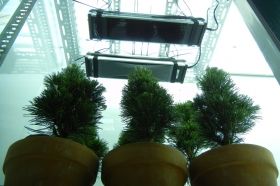The effect of high UV on conifers and potentially other trees also suggests caution today in introducing chemicals that deplete Earth’s ozone layer, which has yet to recover after a global ban on chlorofluorocarbon refrigerants in the 1980s instituted after ozone holes developed over the poles. Some industrial chemicals also destroy atmospheric ozone, which is the planet’s sunscreen, protecting all life from excessive UV rays, in particular UV-B wavelengths, which causes mutations in DNA.
Results of the experiment, which was conducted by University of California, Berkeley graduate student Jeffrey Benca, were published today in the online journal Science Advances.
Benca irradiated 18-inch-tall, bonsai-like pines with UV-B dosages up to 13 times stronger than on Earth today, simulating the effects of ozone depletion caused by immense volcanic eruptions that occurred at the end of the Permian Period. During the two-month experiment, none of the trees died but all seed cones, or pine cones, shriveled up only days after emerging, leaving the trees sterile.
Continue reading at University of California Berkeley
Image via Jeffrey Benca, University of California Berkeley


